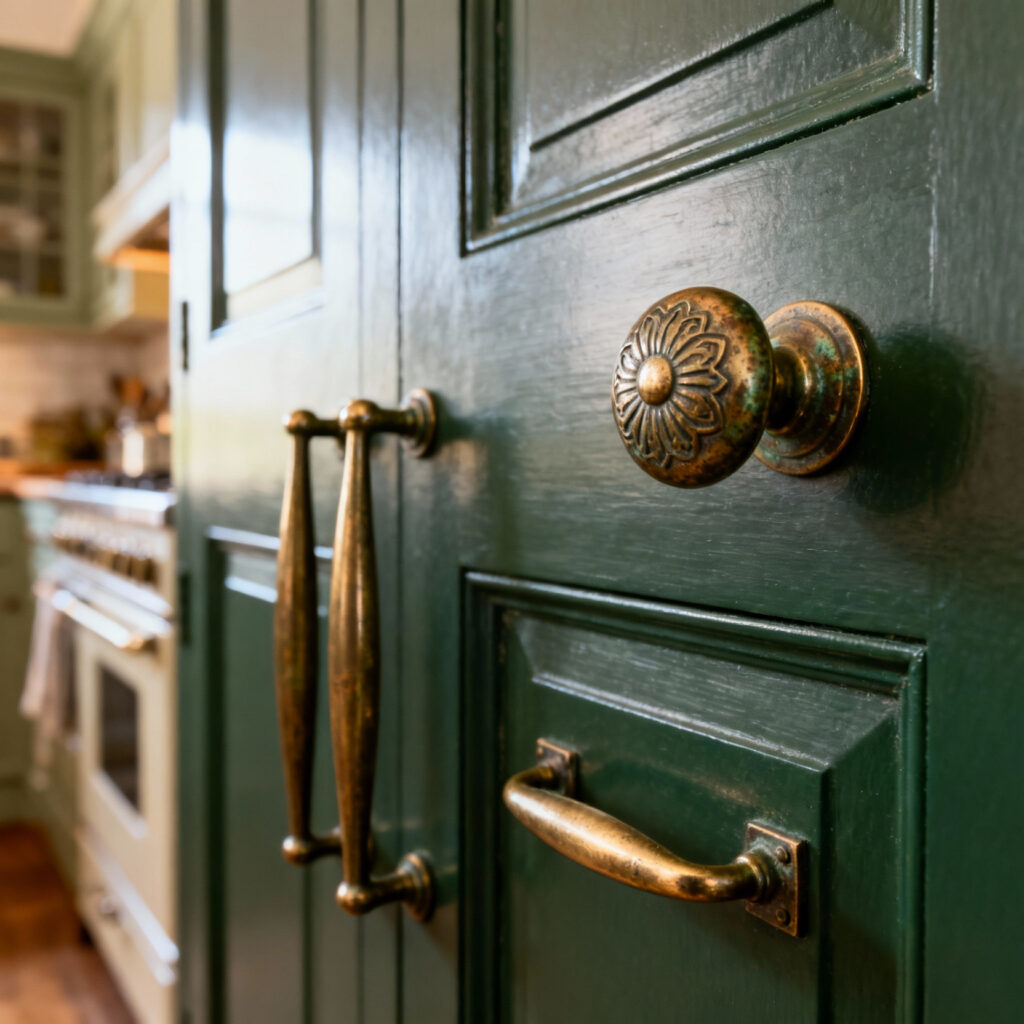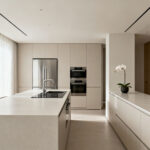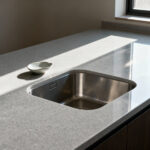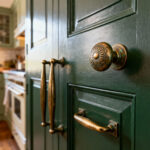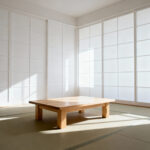For centuries, anyone with a lick of design sense—from the King’s own cabinet makers to the architectural doyens of Mayfair—has known an immutable truth: genuine style is whispered in the smallest of details. They understood that kitchen cabinet hardware was never just a functional necessity, but the final, declarative word in a room’s story. Now, it seems we’re ready to peel back the curtain on their rather closely-guarded principles. These aren’t the fleeting fancies you’ll find splashed across the internet; they are the enduring doctrines that distinguish a merely finished kitchen from a truly curated one.
This is your guide to navigating that distinction. Think of it as a journey from the philosophical bedrock of why a certain pull feels right in your hand, to the alchemy of materials that age like a fine claret, and finally, to the symphony of placement that orchestrates the entire space. We’ll cover everything from the historical authenticity that honours a room’s bones to the subtle art of mixing metals without it all going pear-shaped. These 20 insights are designed to arm you with discernment, transforming your kitchen from a functional space into an artful, enduring legacy.
Part I: The Philosophical Bedrock of Tactile Design
Before one even considers a finish, one must consider the philosophy. The choices we make here are not merely decorative; they are the foundational principles that determine whether a kitchen feels authentic, harmonious, and a genuine pleasure to inhabit.
1. Deciphering Period Authenticity
The soul of a good kitchen often lies in its deference to the building’s own history. Aligning hardware with architectural provenance isn’t about creating a museum piece; it’s about engaging in a respectful conversation with the past. One must ask: what would a Georgian-era artisan have chosen, given their tools and tastes? The answer informs why a simple, weighty brass knob feels so utterly at home in a Bath townhouse, while a fussy, ornate handle would feel like an uninvited guest.
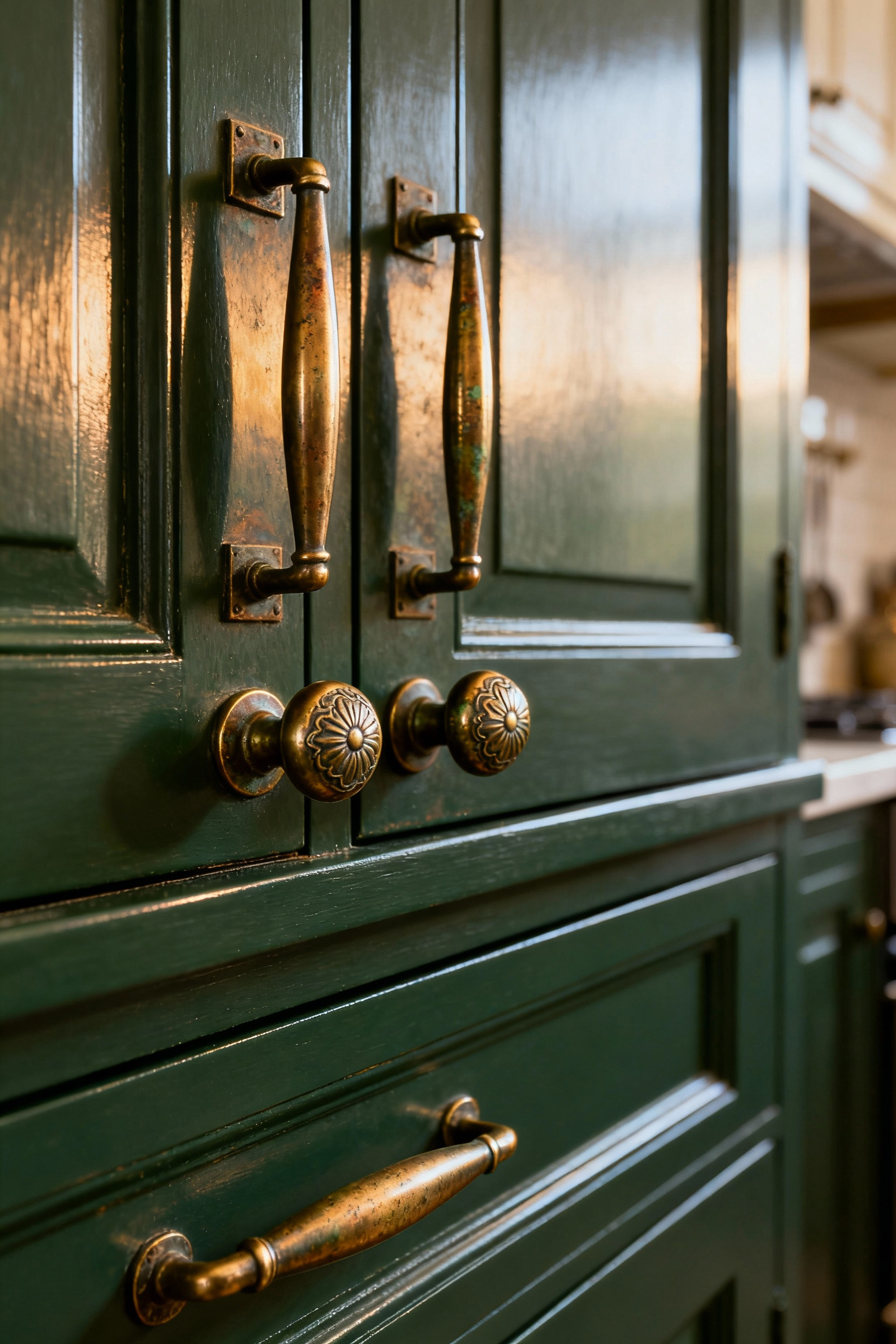
Choosing with historical sensitivity prevents the sort of anachronistic clash that can cheapen an otherwise beautiful space. I’ve noticed in my heritage integration projects that it’s about understanding the spirit of the era. A Craftsman home, for instance, with its honest-to-goodness celebration of materials, demands hardware with a hand-forged feel in bronze or iron. It speaks the same language as the rest of the house. This thoughtful selection ensures a kitchen feels not just updated, but timeless—an organic evolution rather than a jarring intervention.
2. The Understated Power of Touch
Beyond how it looks, how does your hardware feel? This is the realm of ergonomics and haptics—a rather grand term for the simple, profound connection we have with the objects we touch every day. A handle should fit the hand with a pleasing, intuitive comfort. It’s a small detail that makes a world of difference over thousands of interactions.
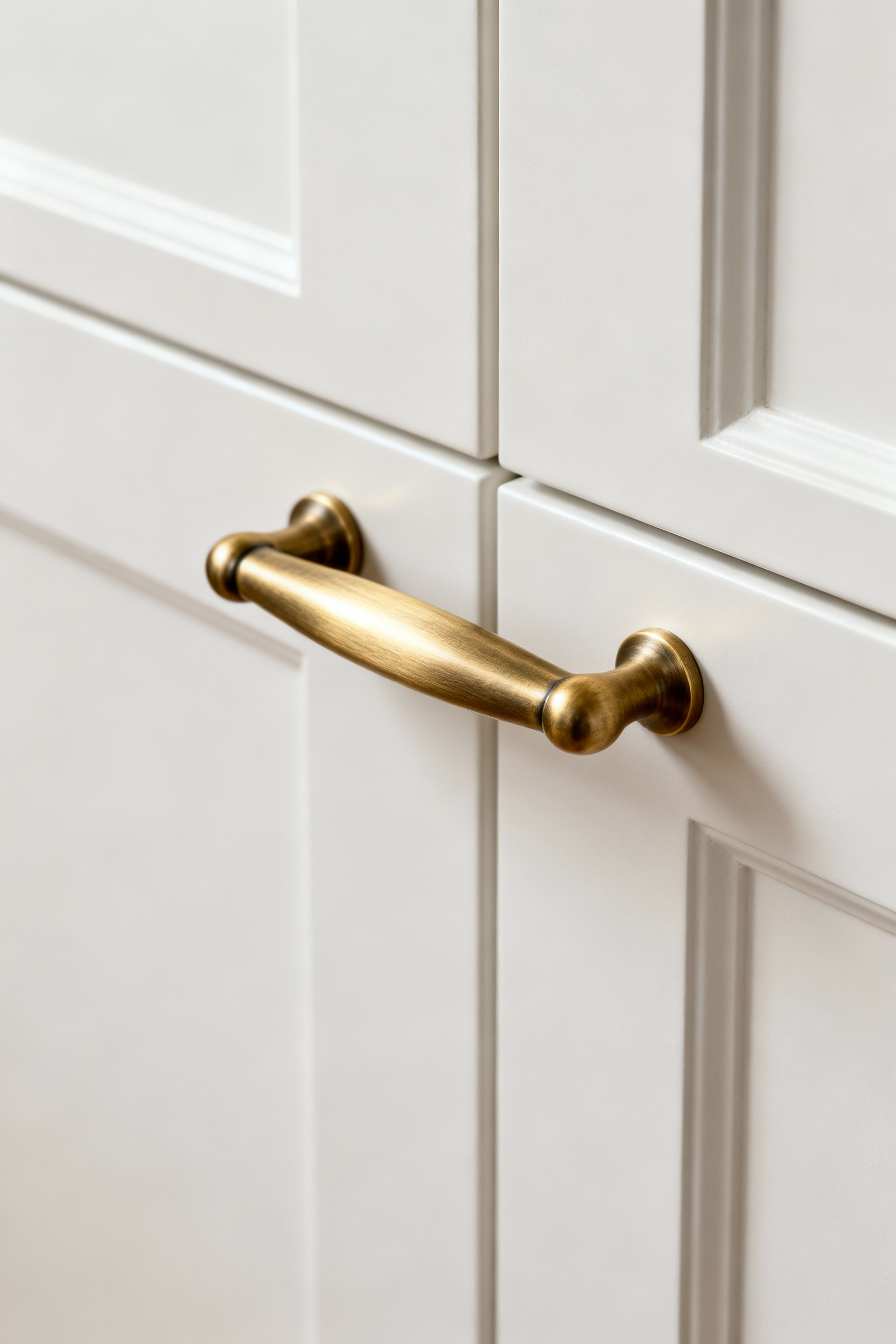
Frankly, there is nothing more disheartening than a beautiful cabinet pull that feels flimsy and insubstantial. It’s a small but constant betrayal of quality. A solid, cool-to-the-touch brass knob or a smooth, weighty pull, however, offers a tiny moment of sensory pleasure. It’s a quiet affirmation of good choice, turning the mundane act of opening a drawer into something satisfying. This tactile connection is how design truly integrates into our daily lives, transforming a kitchen into a space that feels as good as it looks.
3. Curating a Cohesive Language
Kitchen cabinet hardware serves as the visual punctuation in the room’s design sentence. Get it right, and you create a clear, cohesive narrative. Get it wrong, and the result is a muddle of confused clauses. The goal is to establish a unified language, where every knob and pull contributes to the same story, even if they aren’t all identical.
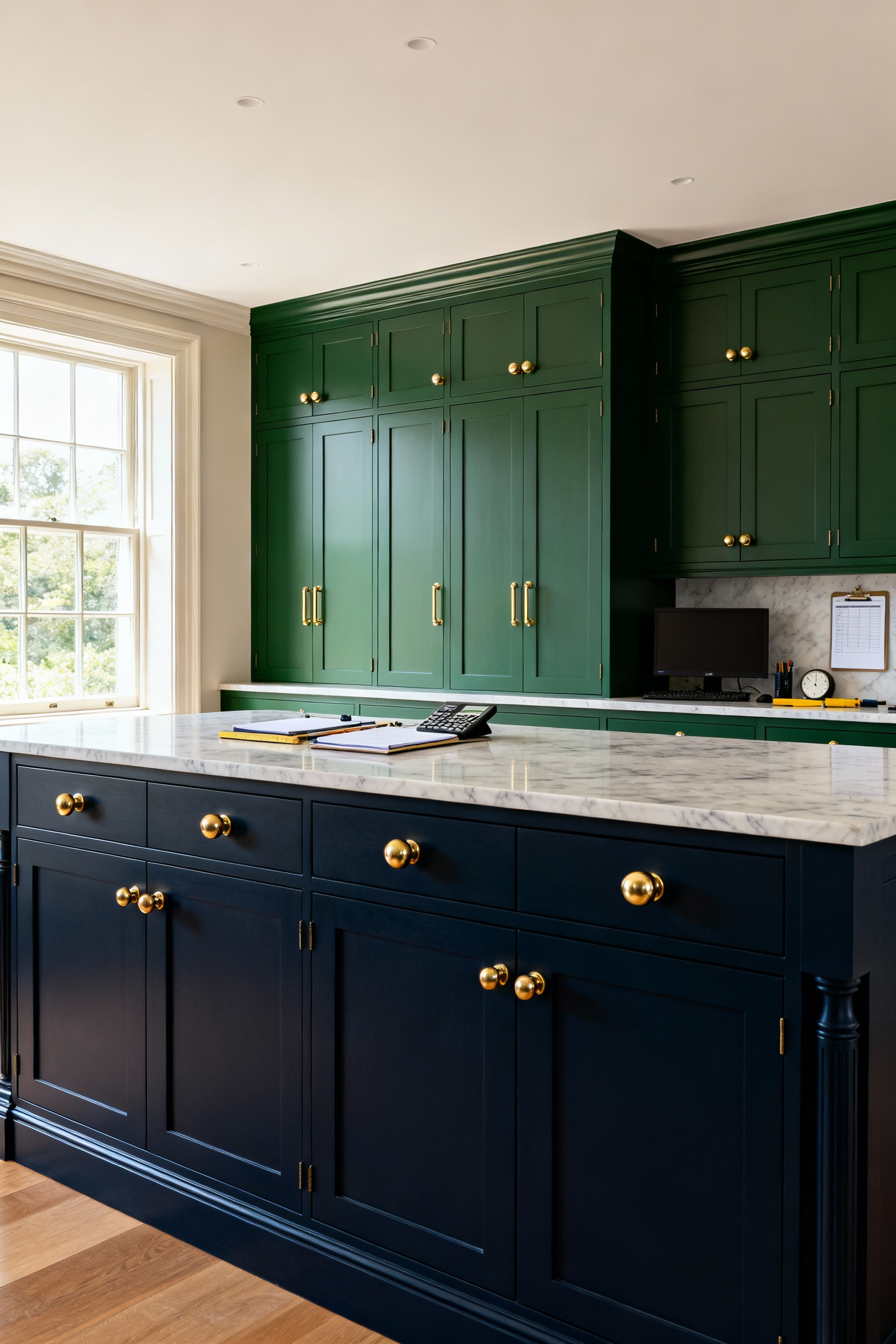
This is about creating a sense of rhythm and balance. Will you use hardware to create long, horizontal lines that draw the eye across a bank of drawers, or vertical pulls to accentuate a room’s height? What I often advise my clients is to think of finishes as the anchor. You might use cup pulls on drawers and knobs on cabinets, but if they share the same burnished brass finish, they will feel like part of the same family. This visual harmony makes a kitchen feel resolved and intentional, a sign of a truly discerning eye.
4. Hardware as the Room’s Catalyst
The very best hardware choices make a subtle statement with an enduring impact. They can act as the narrative catalyst, whispering a story about the home and its inhabitants. The philosophy here is a belief in the quiet power of understatement; these are objects chosen for their intrinsic merit, not because they are shouting the latest trend.
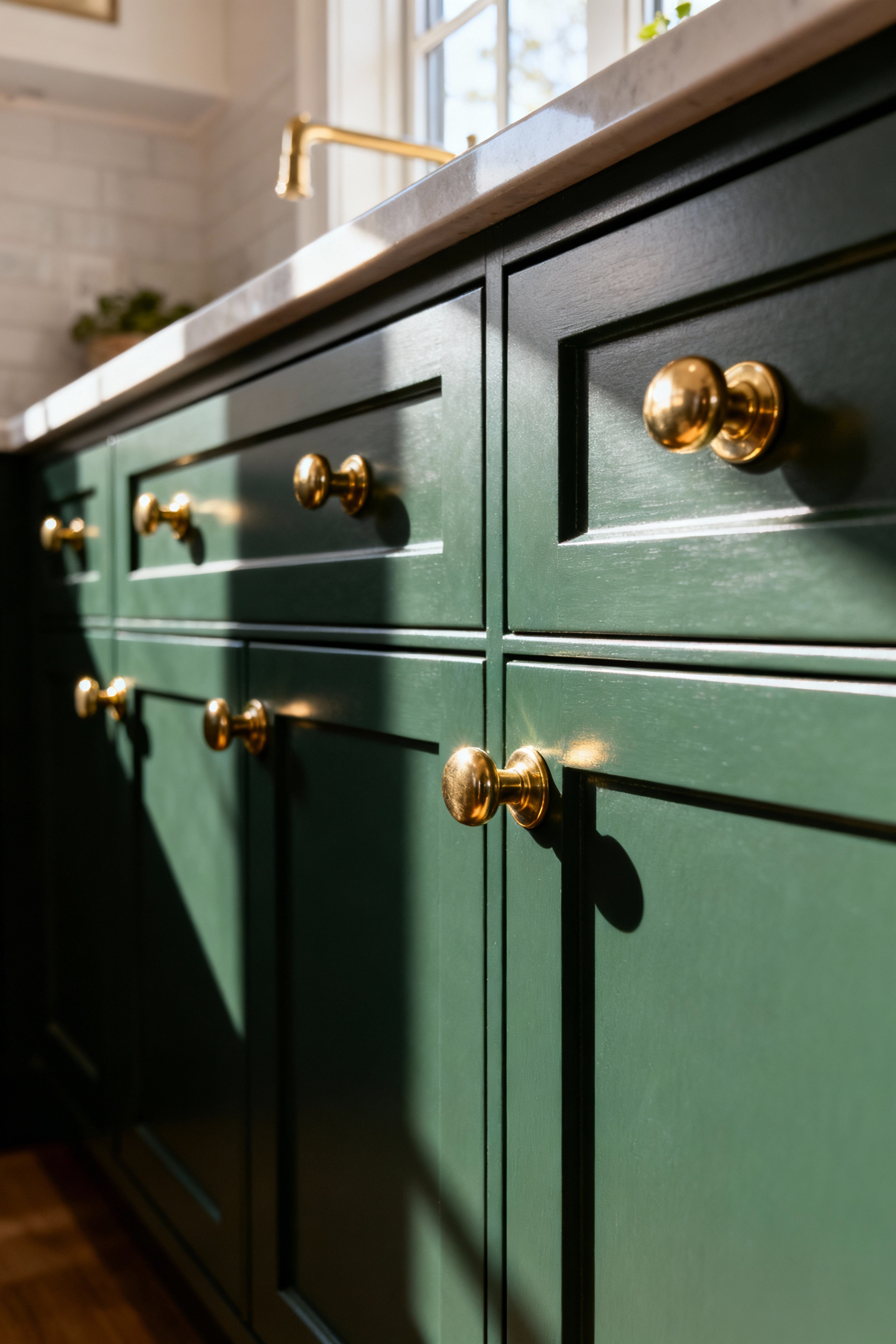
A wonderful way to achieve this is with a ‘living finish’ like unlacquered brass. It’s not just a finish; it’s an evolving material that develops a unique patina over time, recording the history of every touch. It gains character, it doesn’t just age. Or perhaps you’ll find a set of antique knobs at a market in Portobello Road. These small, considered choices are personal signatures, turning a kitchen into a testament to thoughtful living rather than just a place to boil an egg.
5. Balancing Timelessness and Trend
Here is where discernment really comes into play. It is a perpetual negotiation between the siren song of the fashionable and the quiet grace of the timeless. A truly future-proofed aesthetic isn’t about ignoring what’s new; it’s about knowing how to integrate a contemporary touch without dating your entire kitchen in five years.
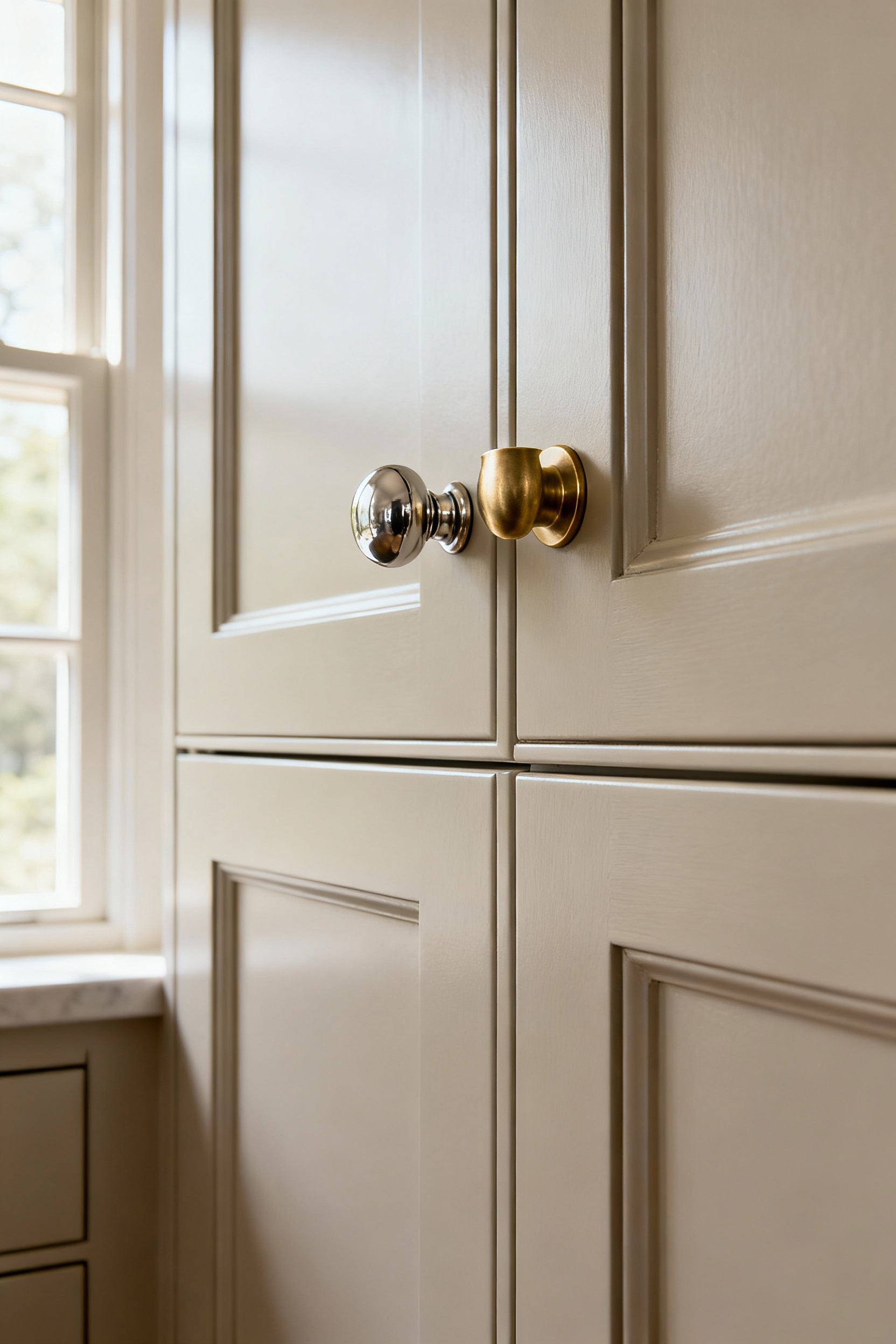
Consider a classic Shaker cabinet. With a simple wooden knob, it’s pastoral and traditional. With a slim, matte black bar pull, it feels crisp and modern. The bar pull is certainly on-trend, but because of its clean lines and neutral finish, it has the legs to endure. Years of working in contemporary British design has taught me to be wary of anything too gimmicky. Your hardware should feel both current and inherently stable, creating a space that matures gracefully alongside you.
Part II: An Ode to Craft & Material
Having established our philosophy, we now turn to the glorious alchemy of the materials themselves. The very substance of your hardware—its weight, its warmth, its reaction to light and touch—is where the real magic happens.
6. The Allure of Unlacquered Brass
There is a certain poetry to materials that tell a story. Unlacquered brass is the ultimate conversationalist, its surface a living canvas that evolves with every touch and change in atmosphere. To choose it is to reject the notion of static perfection and embrace a dynamic, soulful beauty that can only be earned over time.
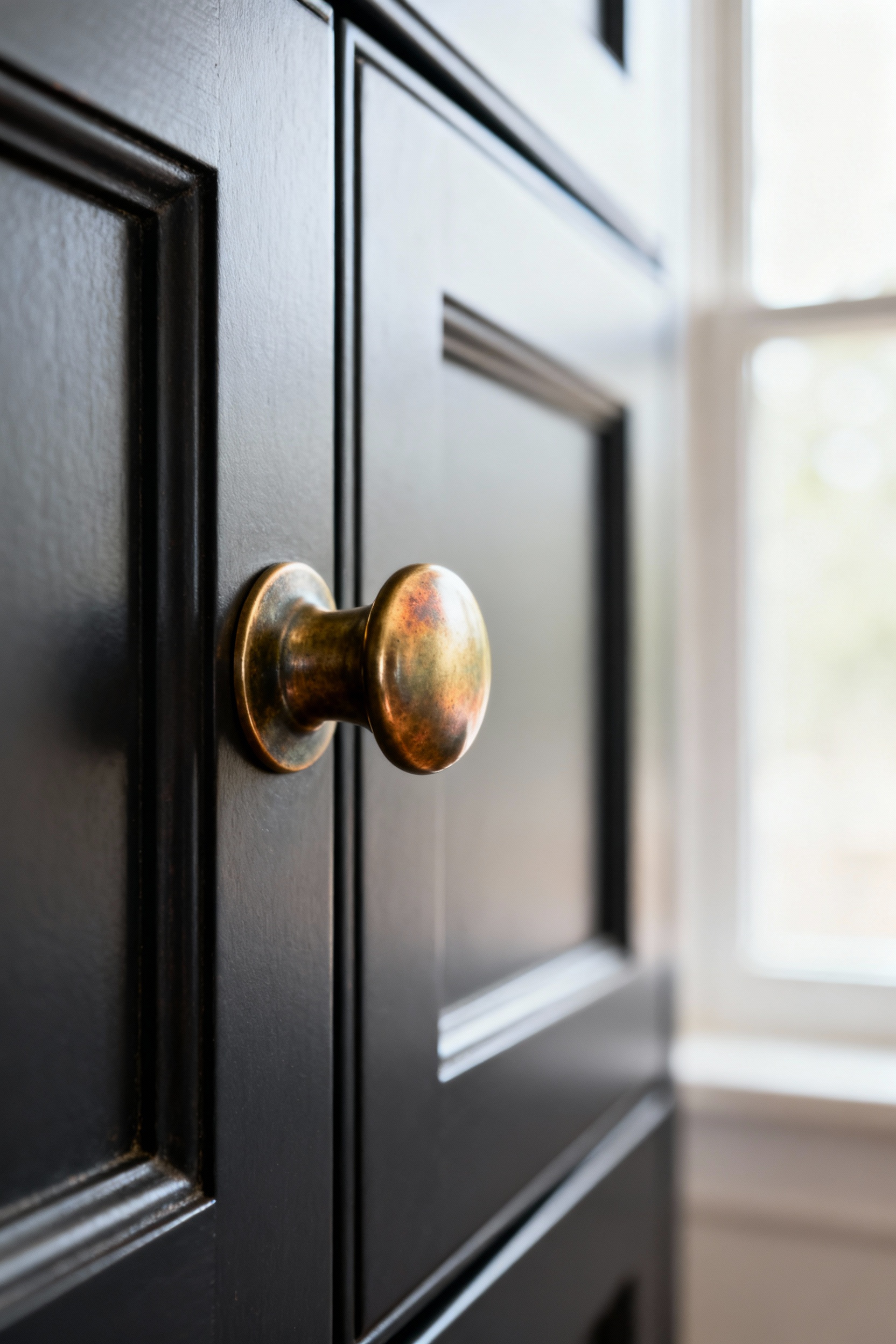
This isn’t decay; it’s character development. The oils from your hands, the steam from the kettle—they all conspire to slowly transform the bright, gleaming gold into a rich, deep bronze. Each piece will age differently, creating a unique patina that is a direct reflection of how you live in your kitchen. It is particularly magnificent against dark, moody cabinetry—think deep greens or inky blues—where its warmth provides a perfect, soulful counterpoint.
7. The Art of Juxtaposing Metals
While a single, uniform metal finish can be beautifully serene, there is a particular artistry in knowing how to mix them. Mastering the juxtaposition of warm and cool tones—pairing a brass with a nickel, for instance—is how you create real visual depth and a highly curated aesthetic. It’s a confident move that signals a sophisticated understanding of design.
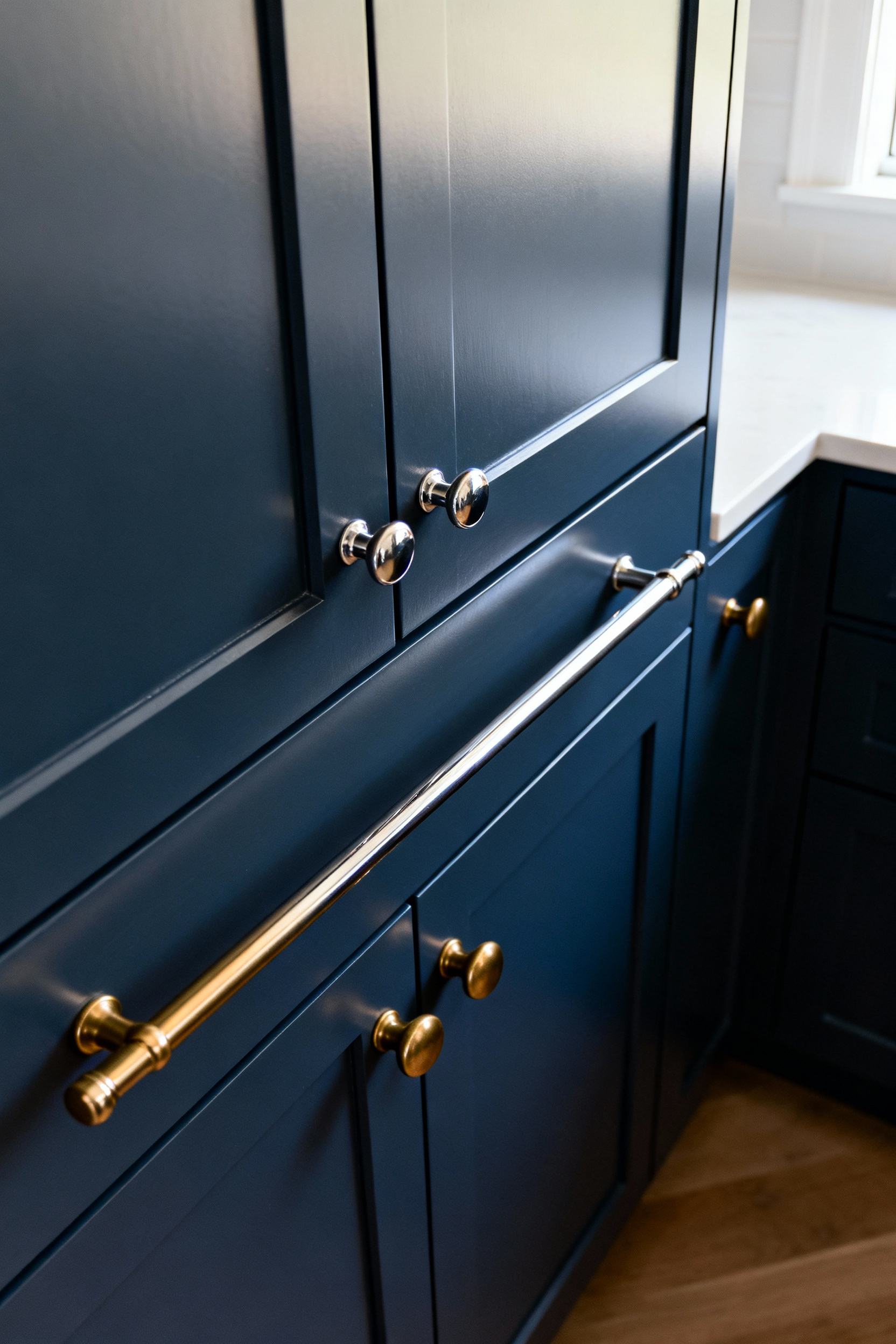
The key is to create a dialogue, not a shouting match. A good rule of thumb is to choose one dominant metal and use the other as an accent. Perhaps the main cabinet hardware is a soft, brushed nickel, while the tap and pendant lights over the island are in a warm, aged brass. This creates an intentional, layered look that feels collected and thoughtful rather than chaotic. It prevents a room from feeling flat or one-dimensional.
8. Introducing Organic Texture: Ceramic, Wood, and Glass
In a kitchen filled with hard, practical surfaces, the introduction of organic materials through your hardware can provide a much-needed touch of warmth and soul. These are the materials that connect us to a sense of craft and nature, offering a tactile experience that metal simply cannot replicate.
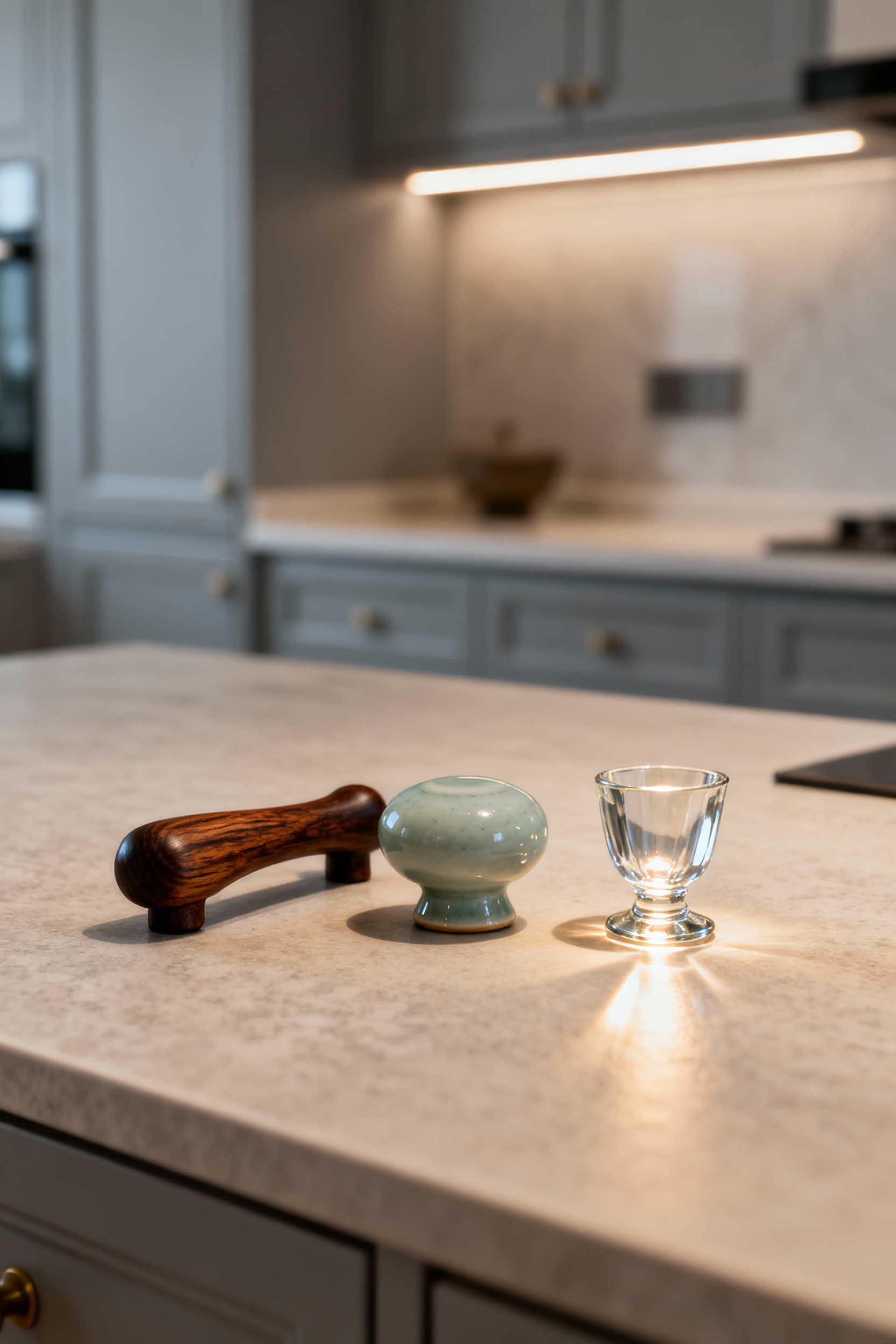
A simple, turned-wood knob on a painted cabinet brings an immediate sense of comfort and understated Scandi-esque or rustic charm. A glazed ceramic knob can introduce a dash of provincial colour or an artisan feel. And glass—especially a vintage-style faceted knob—catches the light like a small jewel, adding a touch of glamour without being ostentatious. These choices transform standard cabinetry into something that feels more like bespoke furniture.
9. The Gleaming Precision of Nickel and Chrome
For those who favour a crisper, more contemporary aesthetic, the refined gleam of nickel and chrome is unbeatable. This is the hardware of precision and order, a choice that reflects a love for clean lines and calm, uncluttered spaces. It speaks of a modern sensibility that finds beauty in flawless simplicity.
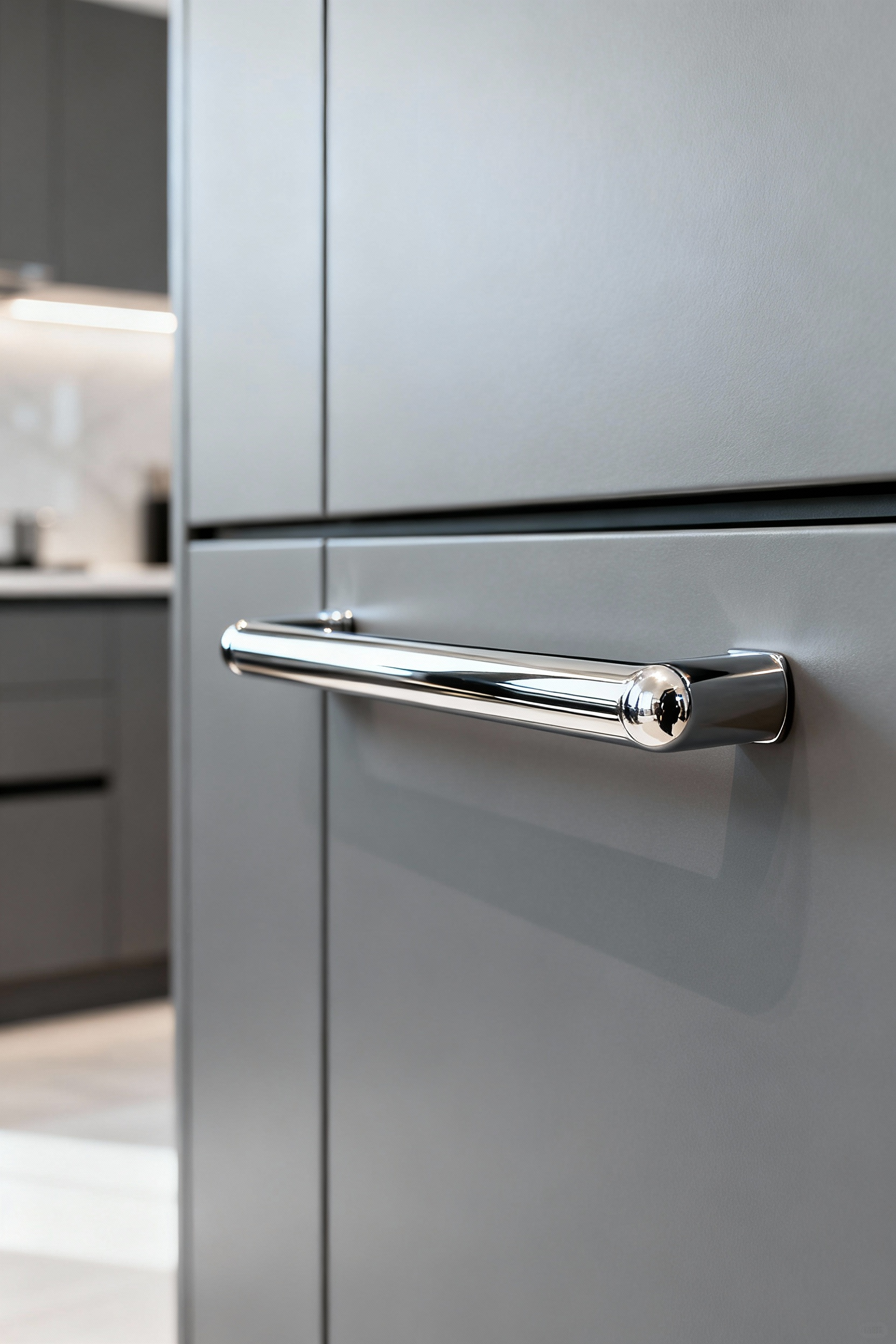
While often spoken of in the same breath, they have distinct personalities. Chrome has a cool, almost blueish tint and a brilliant, mirror-like shine—perfect for a sharp, industrial-chic look. Nickel is slightly warmer, with a softer, more luxurious gleam that works beautifully in transitional spaces. For a more understated look, a brushed or satin nickel finish hides fingerprints and offers a muted, sophisticated shimmer. These are the choices for a kitchen that is sleek, efficient, and impeccably polished.
10. Hardware with a Conscience and a Pedigree
In a world of mass production, there is a growing, and I think wonderful, appreciation for things with a known story. Choosing hardware that is ethically sourced or produced by artisans isn’t just a style choice; it’s a statement of values. It’s an investment in quality that respects both the planet and the integrity of traditional craftsmanship.
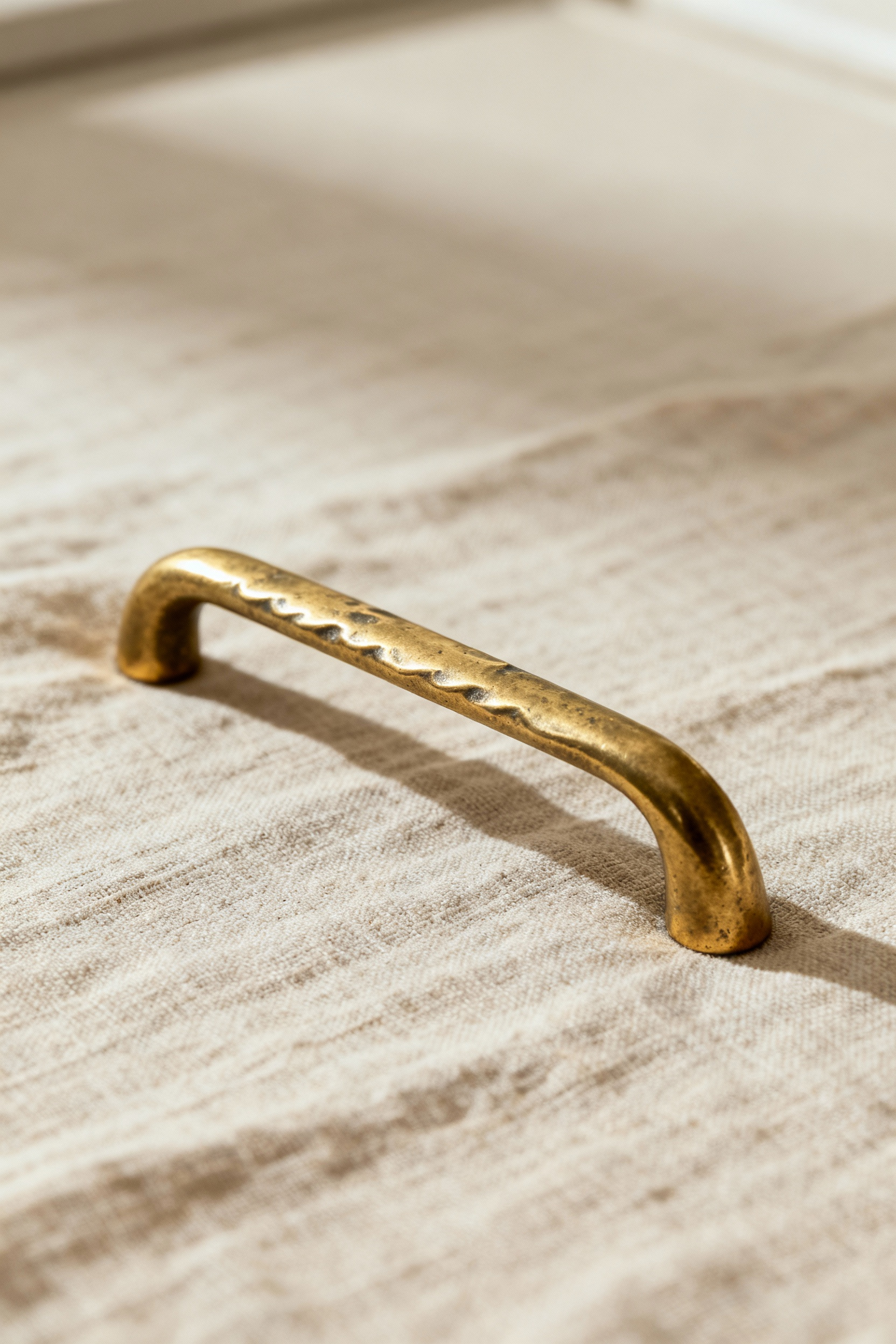
I once worked on a project where we used pulls cast by a small foundry in the Midlands. The slight variations in each piece, the knowledge of the hands that had shaped them—it gave the entire kitchen an unmistakable soul. This hardware doesn’t just function; it has a pedigree. It enriches your home not only with its beauty but with the integrity of its creation, weaving a deeper, more meaningful narrative into your space.
Part III: The Spatial Symphony of Placement
You may have chosen the most exquisite hardware imaginable, but if it is placed incorrectly, the entire composition will falter. The strategic placement of hardware is a fine art, a dance of proportion, purpose, and visual rhythm.
11. Calibrating Scale to Cabinetry
Scale is everything. The relationship between your hardware and the cabinet it adorns must feel balanced and intentional. It’s a design sin to place a tiny, delicate knob on a vast pantry door, where it will look lost and frankly, a bit silly. Conversely, an oversized industrial pull will completely overwhelm a small drawer front.
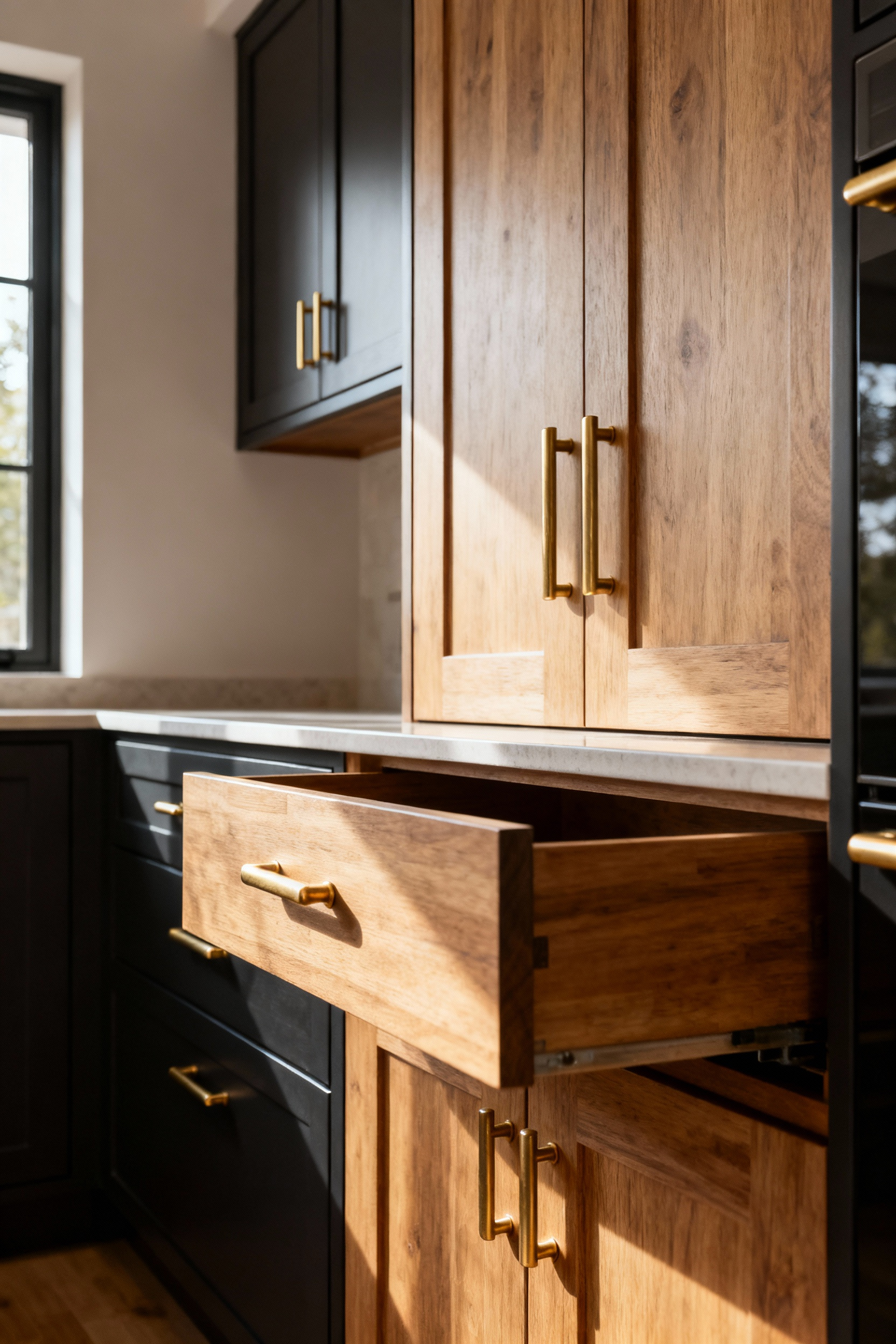
It’s about visual weight. A solid brass pull feels heavier than a ceramic one of the same size. What I tell my clients is to hold the piece up to the cabinet before committing. Does it assert its presence appropriately? Or does it dominate? On a bank of wide pan drawers, a substantial pull is not just visually necessary; it’s ergonomically essential for handling the weight within. Proper scale ensures your hardware feels perfectly, intuitively right.
12. The Art of Asymmetric Balance
While symmetry offers a pleasing sense of calm and order, a touch of asymmetry can introduce a dynamic, captivating energy. This is not about randomness; it is about creating a deliberate, controlled deviation from the expected that feels more like a curated art composition.
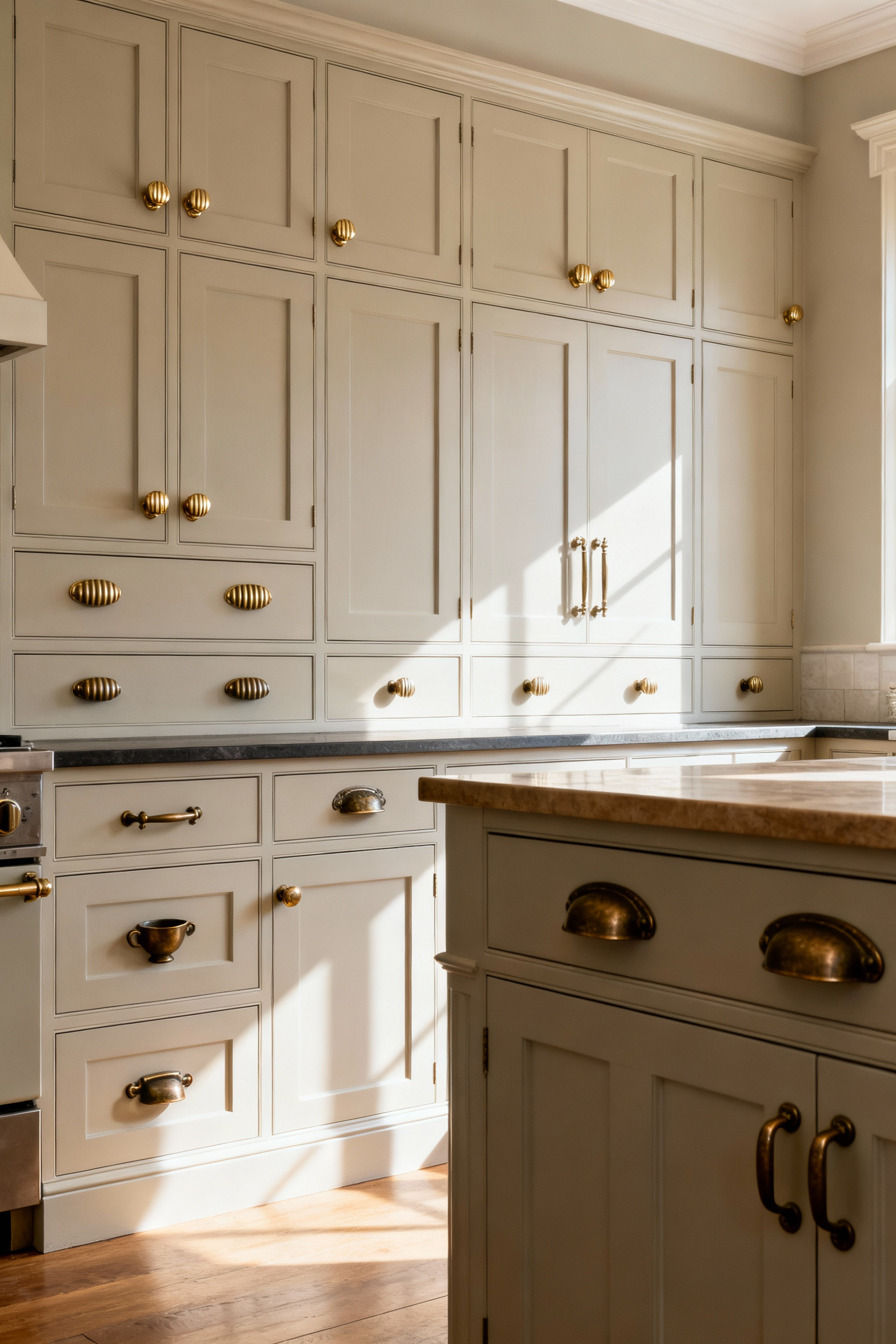
Think about a tall, integrated fridge panel. A single, long pull placed slightly off-centre—perhaps aligned with the edge of an adjacent cabinet—can look incredibly chic and modern. It breaks up the monolithic surface and creates a point of interest. This approach reflects a design confidence that values individuality and subtle visual play over rigid formality.
13. Unifying Disparate Kitchen Zones
The modern kitchen often contains several distinct zones—for prep, cooking, storage, and so on. The trick is to acknowledge these different functions with varied hardware while maintaining a unified aesthetic. This is the principle of “unity through variety.”
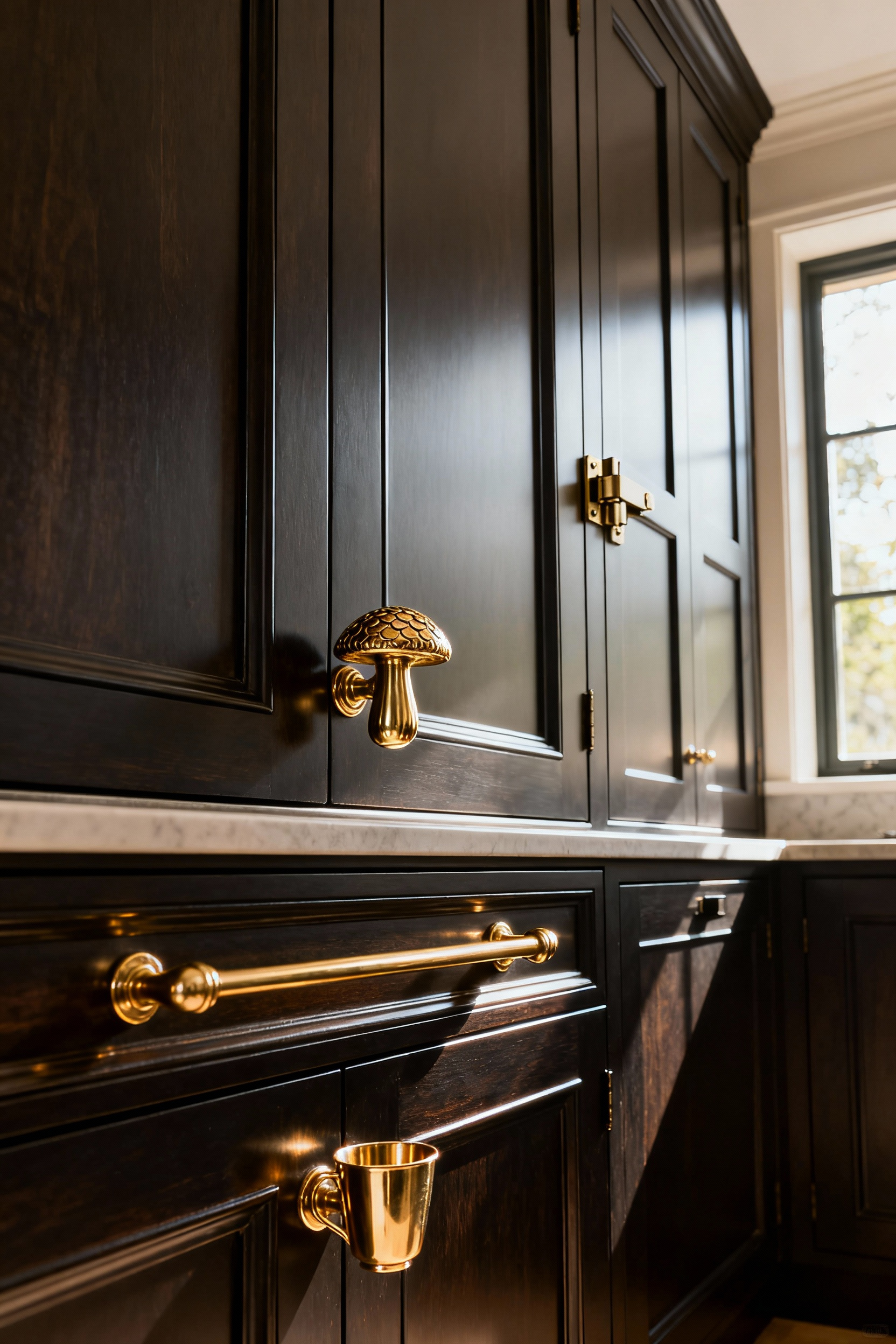
You can achieve this by sticking to a single finish while varying the form. Perhaps you use cup pulls on all the drawers, elegant knobs on the upper cabinets, and a robust latch on the pantry door. Because they are all finished in, say, aged bronze, they speak a common language. This approach creates a sophisticated, layered look that acknowledges different needs without sacrificing visual cohesion.
14. Concealing Integrated Appliances
Nothing says ‘bespoke kitchen’ quite like seamlessly panelled appliances. The key to pulling off this illusion is the choice of the large-scale appliance pull. It must be beautiful enough to belong, yet strong enough to open a heavy, suction-sealed refrigerator door without a wobble.
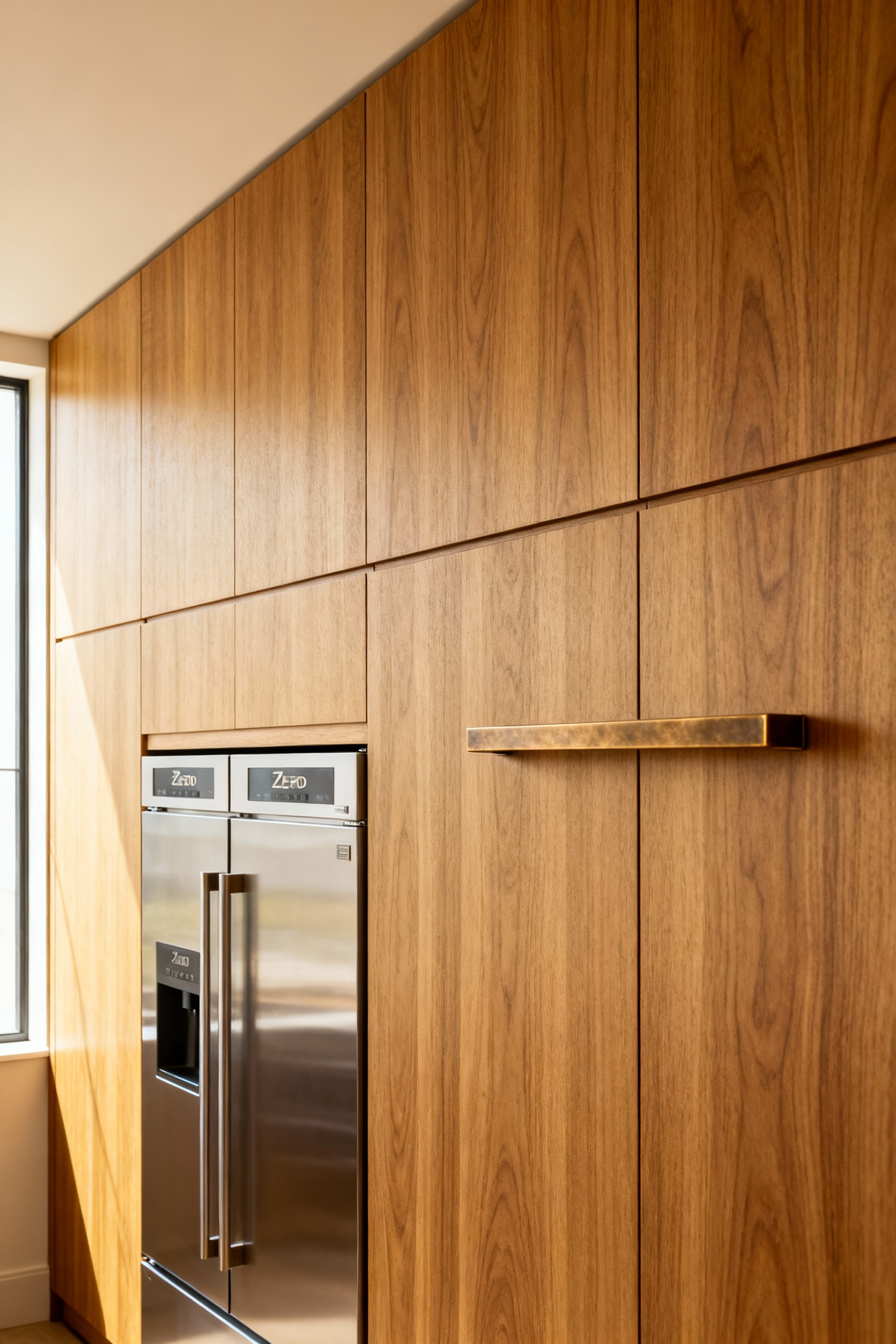
This is not a place to skimp. You need a solid, robust pull with a comfortable grip. Often, a long bar pull that runs much of the panel’s height or width is a brilliant choice, as it integrates into the lines of the cabinetry. It should be strong enough for the task, but discreet enough to maintain the magic of concealment, contributing to the serene, uncluttered elegance of the kitchen.
15. Heightened Ergonomics for Tall Cabinets
Tall, floor-to-ceiling cabinetry presents a unique ergonomic challenge. How do you comfortably reach the latch for that top cupboard where the Christmas plates live? The solution lies in longer pulls and intelligent placement.
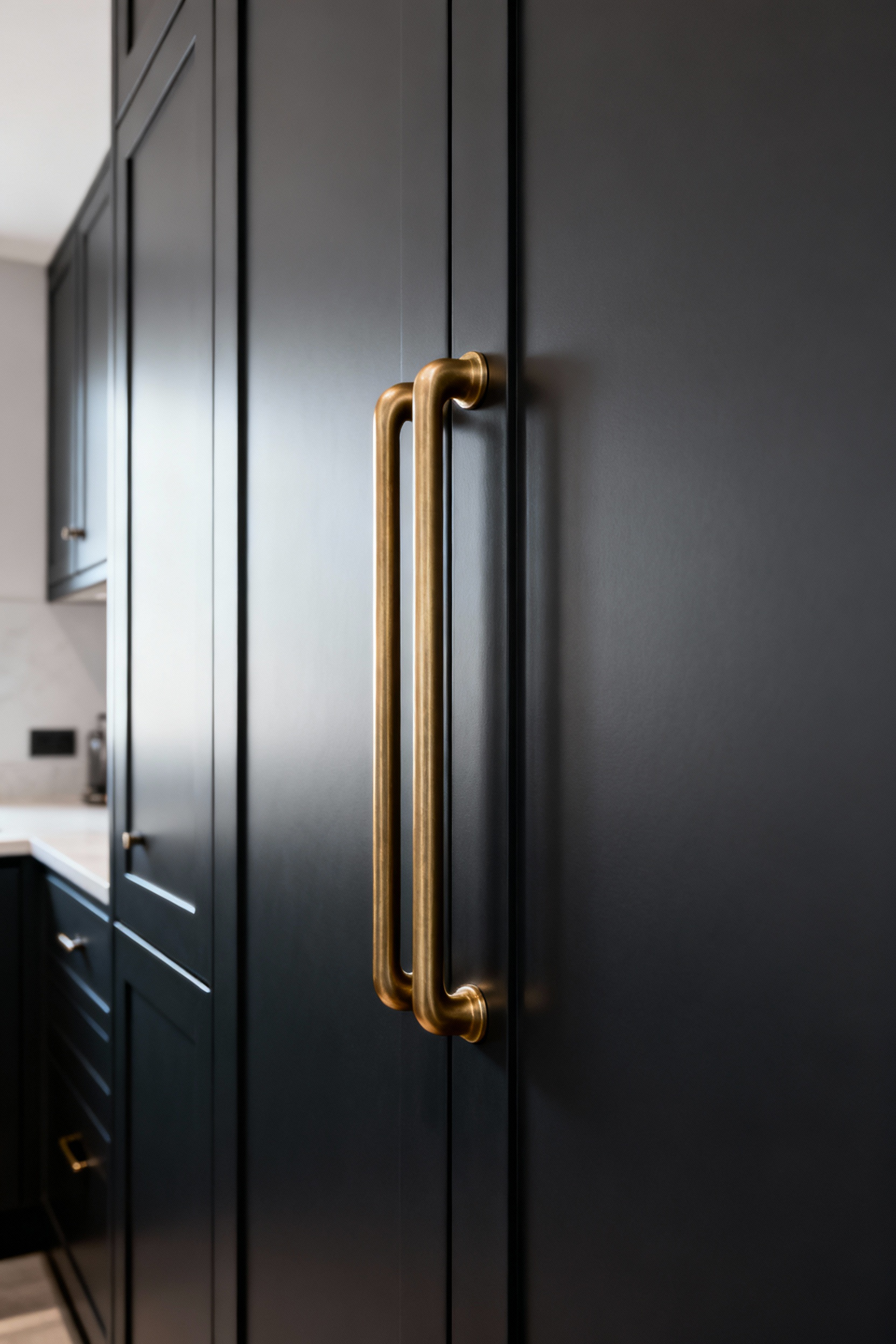
A long bar pull on a tall cabinet offers multiple gripping points for people of different heights. For an upper cabinet door, placing the pull so its lower end is within easy reach is far more practical than centering it. For the cabinet below, placing the pull a little higher than centre avoids awkward stooping. It seems a small thing, but years of living with these details have taught me that this is precisely the kind of thoughtful design that separates a good kitchen from a great one.
Part IV: The Continuum of Legacy & Lifestyle
Finally, we arrive at the most personal aspect of all: how your hardware reflects and supports the way you actually live. These choices are about creating an enduring legacy, ensuring that your kitchen is not just a passing fancy but a timeless, functional joy.
16. Mitigating Wear and Tear in a Busy Kitchen
A kitchen is a workshop, and in a busy, high-traffic home, your hardware must be up to the task. This is about choosing for resilience without compromising on style. A plated finish might look lovely at first, but it can chip and wear away over time, especially on the bin pull that gets used fifty times a day.
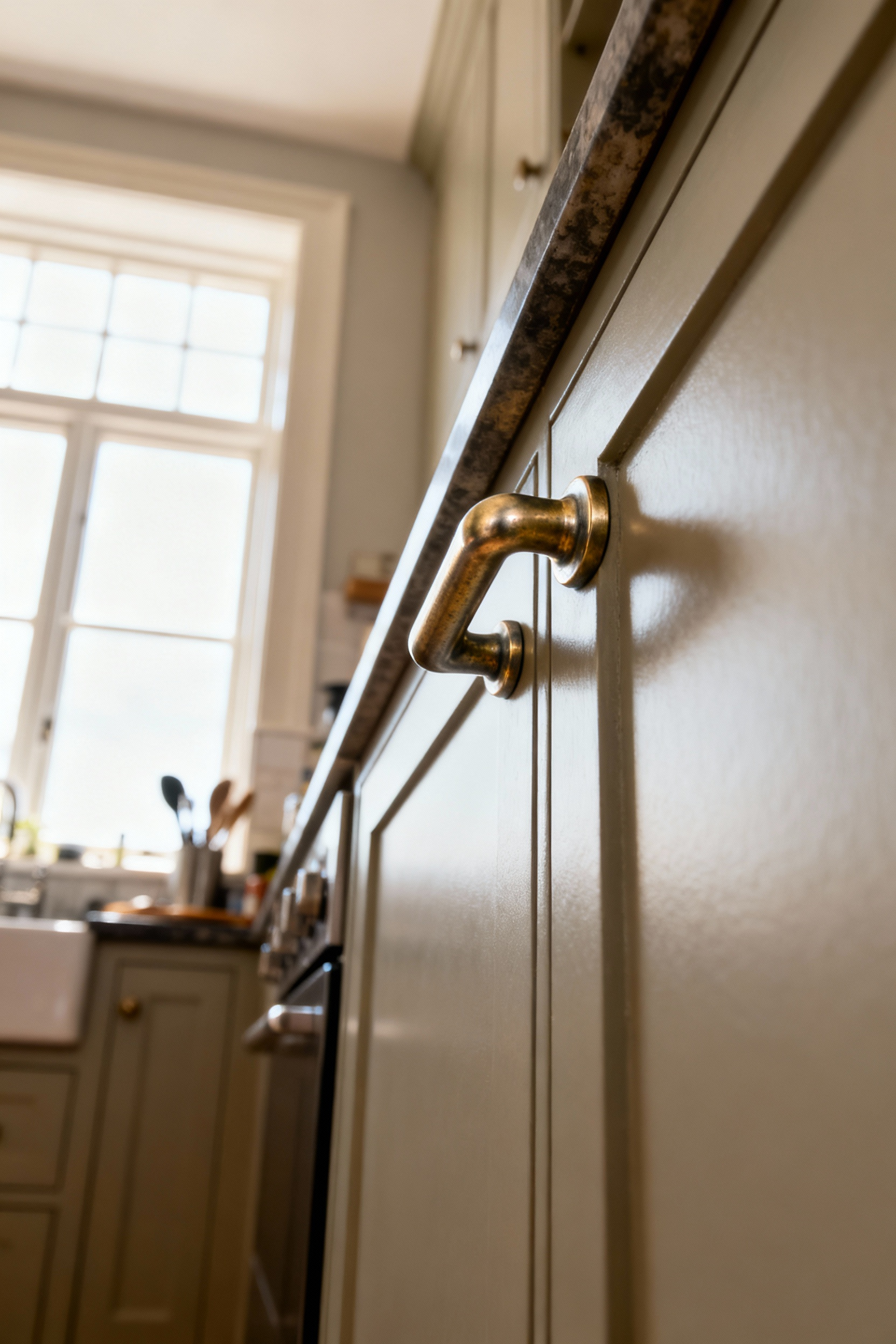
Solid brass, stainless steel, or bronze are the true workhorses. Their beauty is more than skin deep. I also find that satin or matte finishes are wonderfully forgiving; they tend to hide fingerprints and minor scratches far better than a highly polished, mirror-like surface. Thinking about how a piece will endure the chaos of daily life is a mark of true design pragmatism.
17. The Simple Art of Maintenance
The longevity of your hardware depends on a little considered care. A harsh, abrasive cleaner can destroy a beautiful finish in an instant. For most hardware, a simple wipe with a soft, damp cloth is all that’s needed.
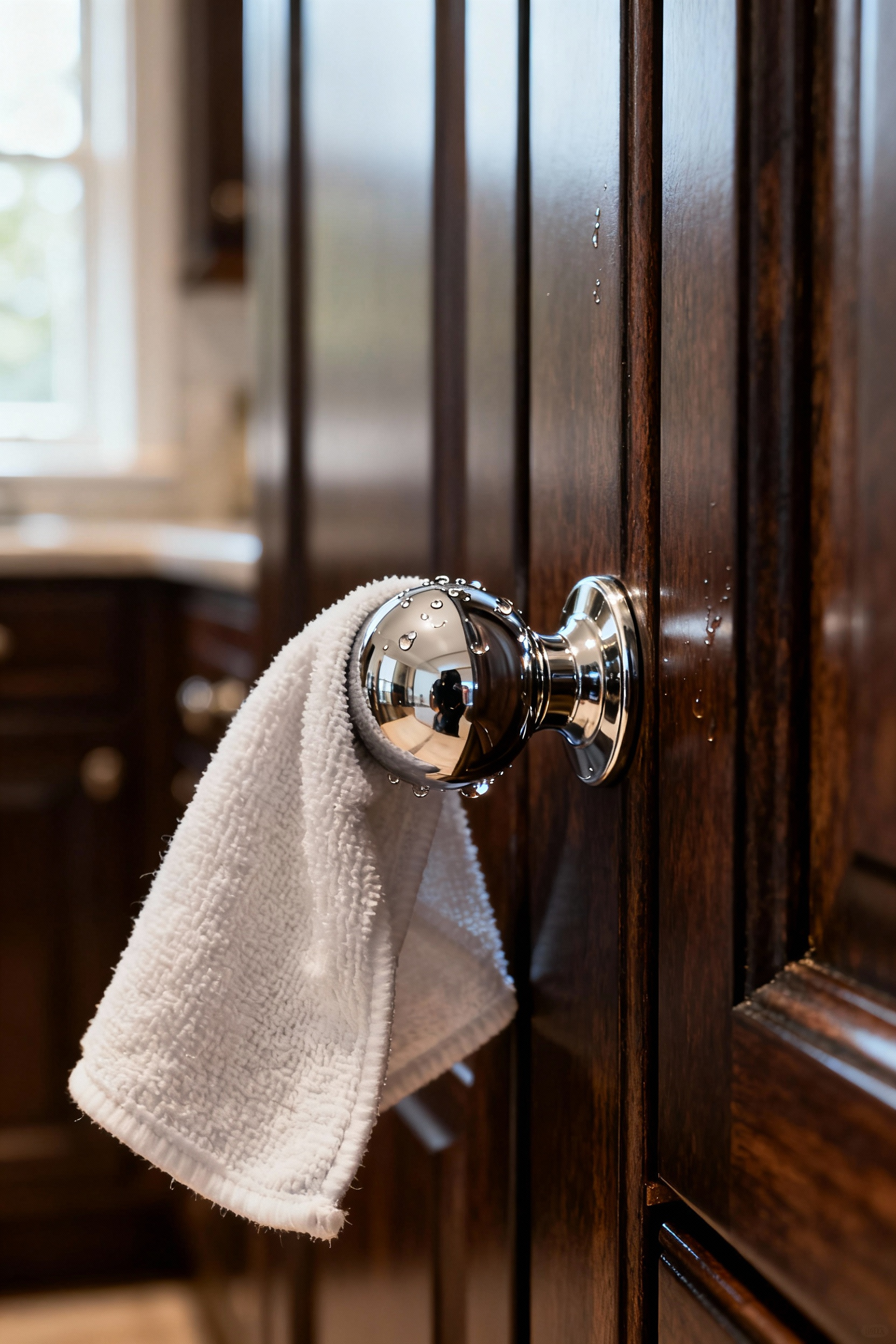
It’s about knowing your material. As we’ve discussed, unlacquered brass is meant to patina; polishing it relentlessly is to miss the point entirely. A lacquered brass, on the other hand, needs its protective coat preserved. By understanding these small distinctions, you ensure your hardware remains beautiful for generations, gracefully withstanding the ebb and flow of domestic life.
18. Universal Design for Effortless Living
Great design is inclusive. Universal design principles simply mean ensuring that your kitchen is accessible and easy to use for everyone, regardless of age or ability. When it comes to hardware, this is remarkably easy to achieve.
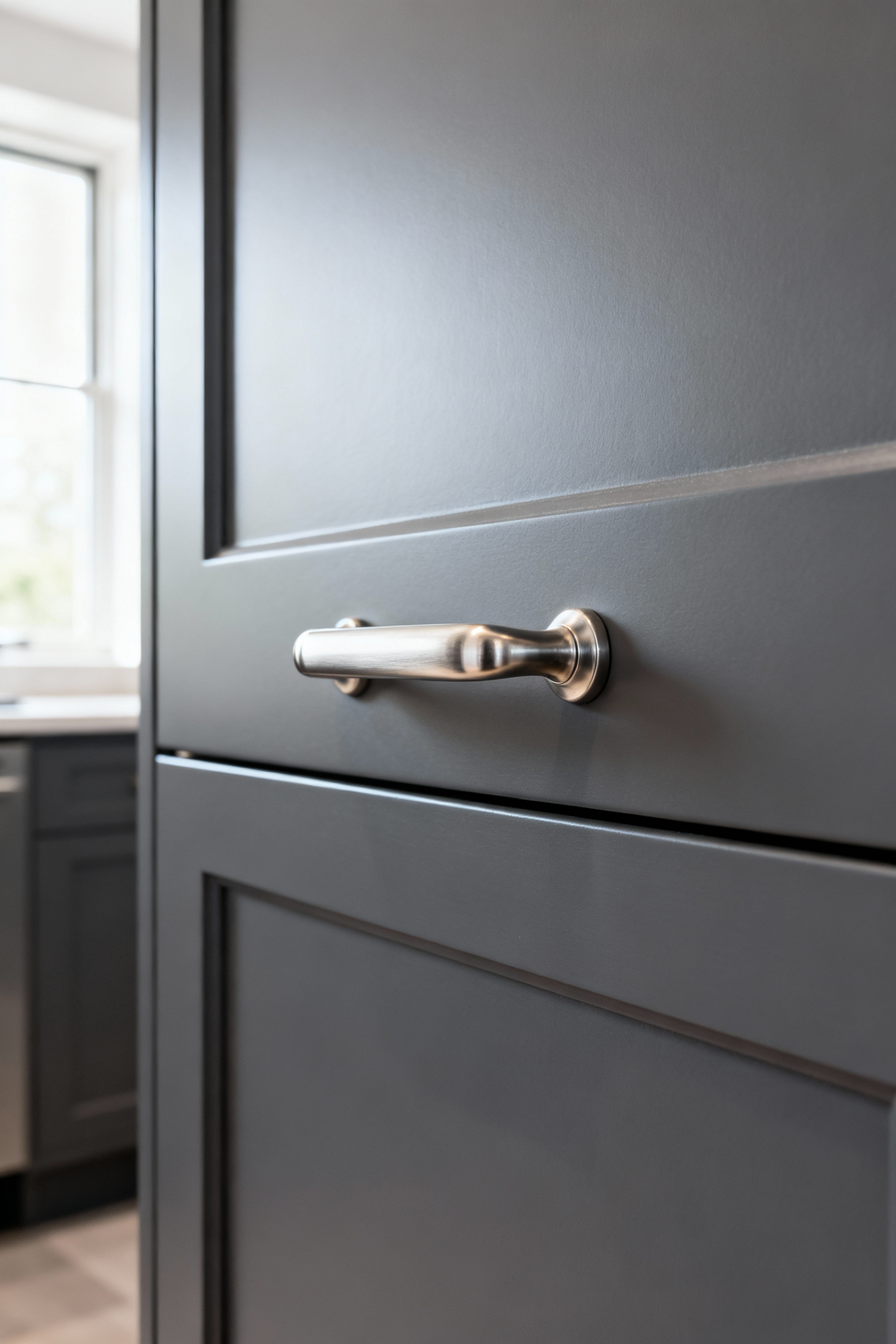
Pulls are generally more accommodating than knobs, as they don’t require a tight pincer grip. A D-shaped pull or a substantial bar pull can be operated with an open hand. Placing hardware where it can be comfortably reached without excessive bending or stretching makes the space more welcoming for all. This isn’t about compromise; it’s about a more thoughtful and empathetic approach to design.
19. The Joy of the Found Object
Sometimes, the most memorable details are the most unexpected. Incorporating bespoke or found objects as hardware is a wonderful way to inject a unique, personal story into your kitchen. It is the ultimate expression of individual style, turning a functional item into a piece of personal art.
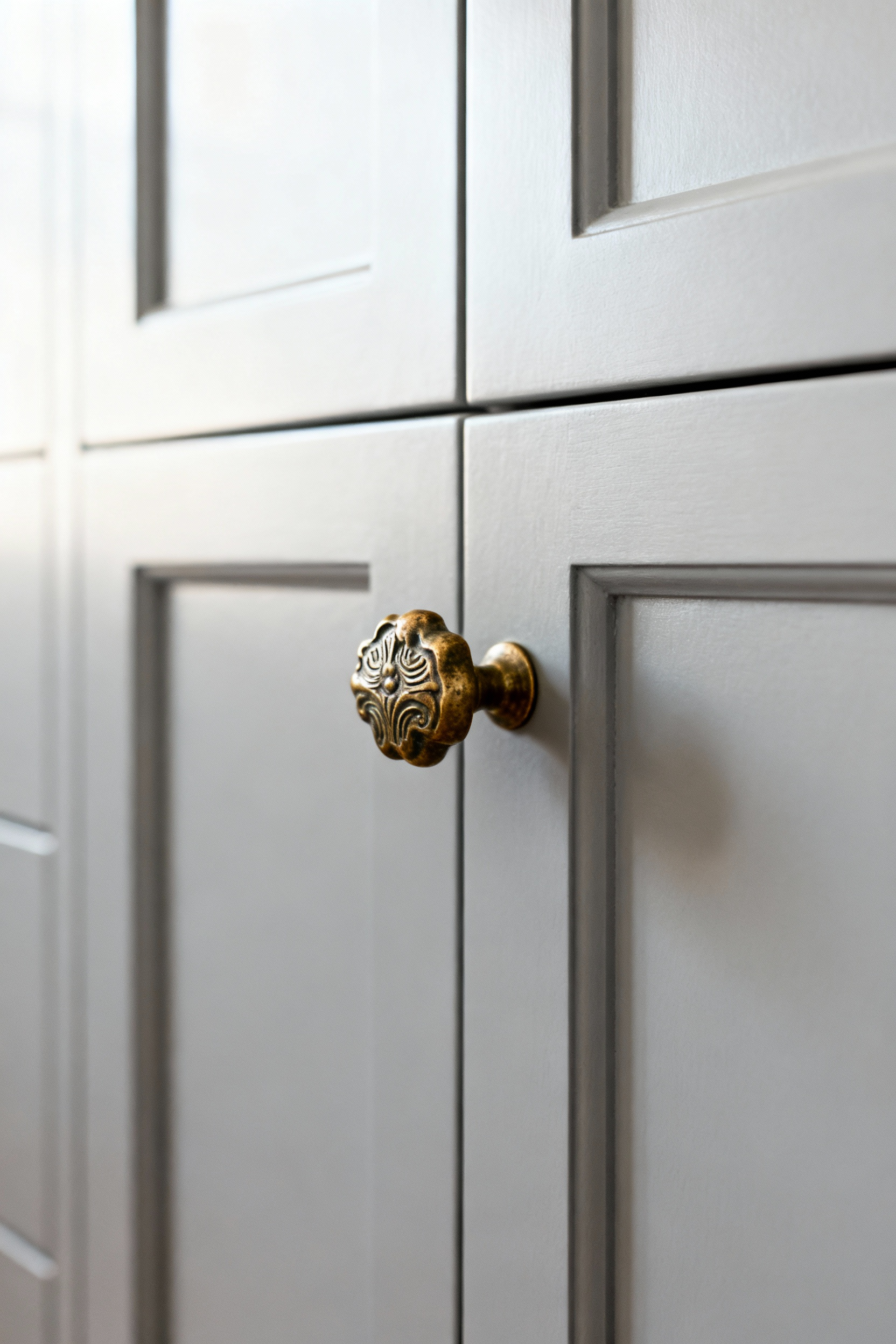
Think of polished stones from a favourite beach, antique silver spoons bent into elegant pulls, or vintage ceramic knobs found in a Parisian flea market. I learned early in my career that the most soulful spaces are those that feel collected, not decorated. One stunning, unique handle on a pantry door can become the signature flourish that makes the entire room unforgettable.
20. Letting Hardware Reflect Your Narrative
Ultimately, your hardware should be a reflection of you. It’s an articulation of your home’s narrative. Do you value the patina of age and history? Are you a modernist who craves clean lines and efficiency? Or are you a romantic who finds joy in a bit of sparkle?
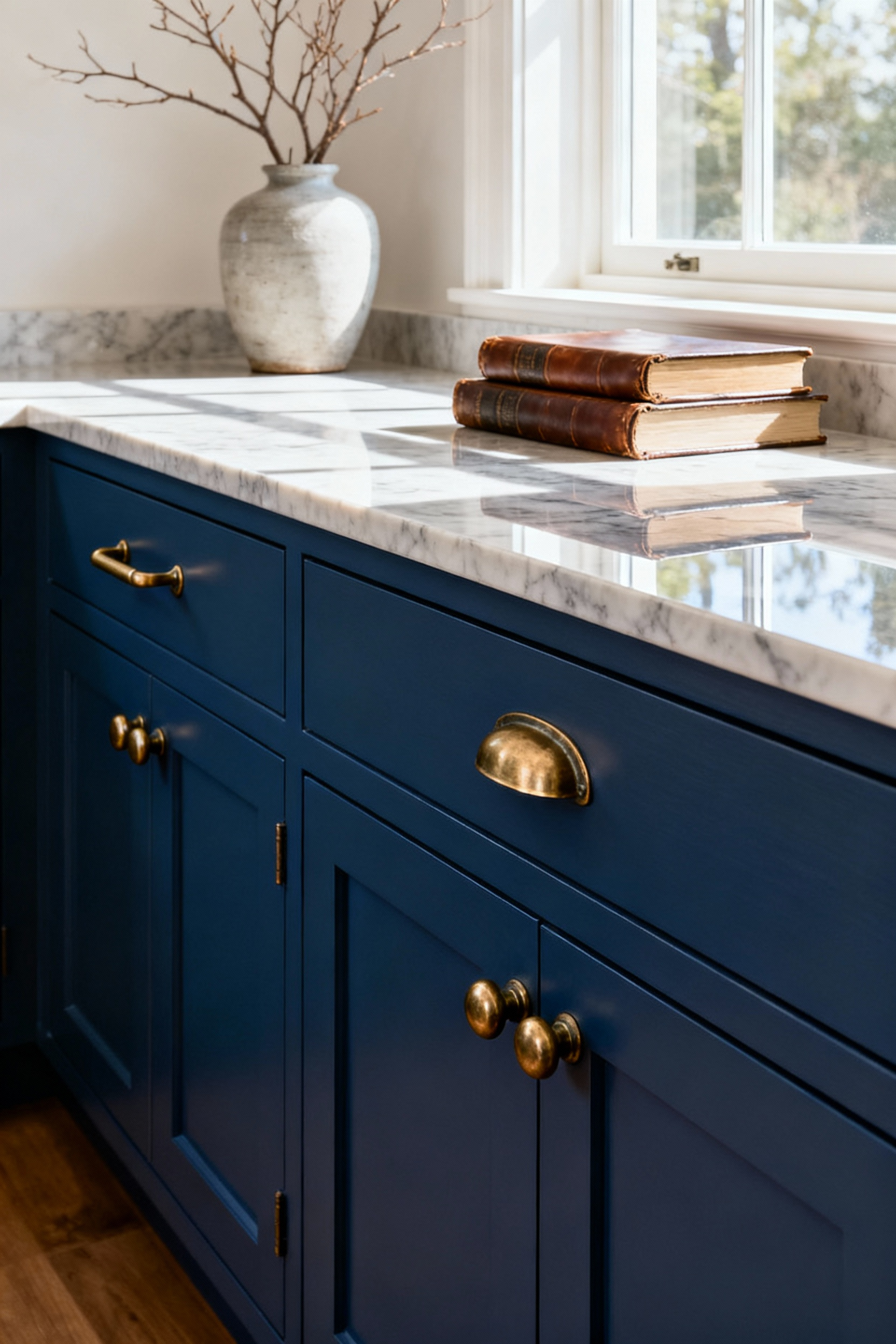
For the frequent entertainer, perhaps crystal knobs add a touch of festive glamour. For the passionate cook, robust, industrial-style pulls might speak to a no-nonsense functionality. Aligning these tangible details with your intangible way of life is the final, crucial step. When your hardware feels like a natural extension of your personal story, it achieves an enduring legacy, telling a tale not of trends, but of a life well-lived.
Conclusion
And there we have it. Having traversed the grand landscape of kitchen cabinet hardware, from subtle philosophy to the glorious reality of a perfectly weighted handle, one thing should be clear: these are not mere accessories. They are the handshakes of your home, the final brushstrokes on your canvas, the punctuation in your domestic story. They are the details that separate the satisfactory from the truly sublime.
To ignore their potential is to miss a delicious opportunity to imbue a room with soul. But armed with a little discernment, you can now curate a collection that speaks to your home’s character and your own personal style. It’s about making choices that feel authentic, function beautifully, and will bring you a quiet flicker of joy for years to come. After all, if the devil is in the details, then so, undoubtedly, is a great deal of delight.
